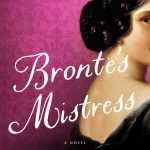In Harper Lee’s To Kill a Mockingbird (1960), the character Atticus Finch says, “You never really understand a person until you consider things from his point of view… until you climb in his skin and walk around in it.” As authors, this is what we do when we choose to write in the first person. We come as close as we ever can to experiencing the world from a perspective that’s not our own. Writing fiction in the first person then is a leap of empathy and imagination, but the challenges this point of view (POV) poses are technical, as well as psychological.
Some writers experiment with POV, trying out omniscient third, close third, and first, before settling on a narrative approach for their book. But when writing my debut novel, Bronte’s Mistress, I was never in any doubt as to whose voice the story needed to be told in. Not only was my book a response to one of the most famous first-person novels ever written, Charlotte Bronte’s 1847 Jane Eyre (“reader, I married him”), but my protagonist, Lydia Robinson, was a woman who’s been vilified through history as being responsible for the Bronte family’s demise. What would she say if she could tell her side of the story? I wondered. And, equally importantly, How would she say it?
Writing Lydia forced me to enter a world (1840s England) in which, even wealthy, women had few choices. She doesn’t own property, she’s never voted, she has no access to divorce. And it also made me confront the technicalities of writing first person prose, a few of which I’ll share with you today.
Placing your narrator in time
You’ve decided you’ll be writing in the first person, but this is just one of a series of hard choices. Now that you have the who, it’s time to think about the when. Will your first person narrator be telling the story from a point in the future? Will they know the story’s destination from the very first line? Think of Charles Dickens’s titular character David Copperfield (1850) or Nick Carraway in F. Scott Fitzerald’s The Great Gatsby (1925).
Choosing a retrospective viewpoint has the potential to make your story more didactic. It’s easier for a character to draw conclusions or moralize with the benefit of hindsight. And there are other advantages. For example, if your character is going to undergo a significant transformation, the older protagonist can excuse, explain or apologize for the behavior of their younger self, maintaining reader sympathy. This makes this choice popular for writers of bildungsroman.
On the other hand, a retrospective first person can distance us from the character in the moment, alienating us from the action, and even intruding on scenes with overly expositional commentary. A retrospective first person can slacken the tension too. A first person character is already unlikely to die, but the existence of an older narrator pretty much precludes this possibility. If you write historical fiction like me, you might also have to pinpoint an exact year from which your protagonist is speaking, giving you a second time period to research and understand.
In Bronte’s Mistress, although the book is in the past tense, Lydia Robinson tells her story as if she’s in the moment and living through the events of the novel vs. relating the events years later. For me, this decision made sense as I wanted readers to feel viscerally with Lydia as she enters into an illicit and dangerous affair. However, I did occasionally miss the tools a retrospective first provides, like giving me the option to foreshadow more overtly.
Experiencing your story through their senses
Writing first person means your story can only contain what the protagonist knows, but this advice goes beyond questions of plot.
Seeing the world through the narrator’s eyes means describing each new setting through the lens of what they would observe—and in the order in which they would notice every detail. Your characters’ senses (sight, hearing, taste, smell and touch) become readers’ only points of access to the world around them. This isn’t a movie where you can start with an establishing shot before zooming in on the face of the character we’re following!
This means you have to be careful that your descriptions seem to fit within your character’s realm of experience. Can your narrator really detail different types of weapons? (Maybe yes, maybe no.) Can they see another character’s expression from so far away?
Watching your metaphors
Linked to this, is the difficulty of handling imagery (for instance, simile and metaphor), when writing in first person.
As with your descriptions, your images need to ring true to the character whose perspective you’re writing from. Would they know these words and think these thoughts? Crucially too, is this an appropriate moment for them to be thinking poetically? Or are you sacrificing believability because you’ve fallen in love with a sentence, phrase or image? If your character starts thinking in too many similes, they may seem distracted from the task at hand.
People have their favorite images and points of comparison, and these are dependent on their interests. Tapping into this can be a great way to establish your character’s personality, but you may also run the risk of making your imagery repetitive. In Bronte’s Mistress, for instance, my character Lydia is a good musician, so she often uses musical metaphors. This was a helpful guide for me, as music gave me a lot of scope to play, without the imagery I employed ever feeling out of place in her narration.
Offering other perspectives
Finally, one of the toughest parts of writing first person fiction is the danger for overidentification between the writer and the protagonist. How can you show that you disagree with your character’s views or actions, if you’re writing from their perspective?
Here, other characters’ voices (e.g. through dialogue) are crucial. Include others’ views to cast doubt on your protagonist’s conclusions or to hint that they might be unreliable. There is also potential to use irony in the same way, having “what happens next” totally contradicting what the first person narrator has thought/said previously.
In Bronte’s Mistress, I had another device to help me do this. I inserted letters addressed to Lydia at various points in my narrative, allowing me to showcase viewpoints that were in opposition to hers, and, of course, play around with additional first person voices!
I hope some of these tips have been helpful to those of you writing fiction in the first person. Writing using the “I” may seem straightforward, but when the going gets tough, remember that what you’re attempting is truly extraordinary. You’re stepping out of your own skin and into someone else’s. What could be more miraculous?

Finola Austin, also known as the Secret Victorianist on her award-winning blog, is an England-born, Northern Ireland-raised, Brooklyn-based historical novelist and lover of the nineteenth century. She has two degrees from the University of Oxford, including a Master’s in Victorian literature. Brontë’s Mistress is her first novel and is available for purchase now. By day, Finola works in digital advertising. Find her online at www.finolaaustin.com, or connect with her on Instagram, Facebook, or Twitter.




 We love helping your growing in your writing career.
We love helping your growing in your writing career.

No Comments